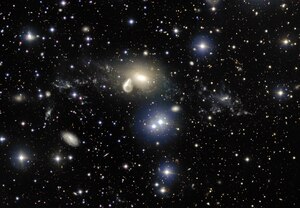NGC 5291
| NGC 5291 | |
|---|---|
 | |
| Observation data (J2000 epoch) | |
| Constellation | Centaurus |
| Right ascension | 13h 47m 24.5s[1] |
| Declination | −30° 24′ 25″[1] |
| Redshift | 4378 ± 6 km/s[1] |
| Apparent magnitude (V) | 15.1[1] |
| Characteristics | |
| Type | E pec[1] |
| Apparent size (V) | 1′.1× 0′.7[1] |
| Other designations | |
| PGC 48893[1] | |
NGC 5291 is a system of interacting galaxies in the constellation Centaurus. It is surrounded by a collisional ring, containing young and actively star forming tidal dwarf galaxy,[2] where dark matter has been detected.[3]
See also
External links
References
- ^ a b c d e f g "NASA/IPAC Extragalactic Database". Results for NGC 5291. Retrieved 2007-04-03.
- ^ Médéric Boquien; Pierre-Alain Duc; Jonathan Braine; Elias Brinks; et al. (2007). "Polychromatic view of intergalactic star formation in NGC 5291". Astronomy & Astrophysics. 467 (1): 93–106. arXiv:astro-ph/0703002. Bibcode:2007A&A...467...93B. doi:10.1051/0004-6361:20066692.
{{cite journal}}: Unknown parameter|last-author-amp=ignored (|name-list-style=suggested) (help) - ^ Frédéric Bournaud; Pierre-Alain Duc; Elias Brinks; Médéric Boquien; et al. (2007). "Missing Mass in Collisional Debris from Galaxies". Science. 316 (5828): 1166–1169. arXiv:0705.1356. Bibcode:2007Sci...316.1166B. doi:10.1126/science.1142114. PMID 17495138.
{{cite journal}}: Unknown parameter|last-author-amp=ignored (|name-list-style=suggested) (help)
